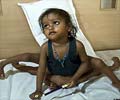Following up on an earlier discovery that a gene called IRF6 is involved in the common birth defect cleft lip and palate, researchers at the University of Iowa…
Following up on an earlier discovery that a gene called IRF6 is involved in the common birth defect cleft lip and palate, researchers at the University of Iowa Roy J. and Lucille A. Carver College of Medicine and their colleagues have identified the function of the gene. Their latest findings, published online Oct. 15 in Nature Genetics, reveal an unexpected role for IRF6 in the growth and development of skin cells, a discovery that may have implications for wound healing and cancer research.
In 2002, Brian Schutte, Ph.D., UI associate professor of pediatrics and nursing, and Jeff Murray, M.D., UI professor of pediatrics, pediatric dentistry and biological sciences, and the Roy J. Carver Chair in Perinatal Health, led a study showing that mutations in IRF6 cause Van der Woude syndrome (VWS), a rare, dominantly inherited form of cleft lip and palate. Subsequently, the researchers found that this gene also is mutated in 10 to 15 percent of the more common, so-called non-syndromic cases of cleft lip and palate. Cleft lip and palate, where the lip or both the lip and palate (roof of the mouth) fail to close, occurs in approximately one of every 1,000 babies.In order to determine the function of this gene, the researchers created mice that lacked IRF6. These mice had very abnormal skin as well as a cleft palate. Detailed analysis of the mice revealed that IRF6 regulates the proliferation and differentiation of keratinocytes -- the main cell type in the epidermis or outer layer of skin. Keratinocytes also provide a protective barrier around the mouth, gut, liver, lung, kidney and other internal organs.
'This study really looks at the role of IRF6 in skin development. By focusing on skin we felt we could learn more about this specific cell type that is also abnormal in the palate,' Schutte said. 'The insight we gained into the function of IRF6 will help focus research efforts to identify other genes involved in cleft lip and palate.'
Skin is an extremely important tissue, as it is the largest tissue in the body and it provides a critical external barrier. Normal epidermis has four layers of keratinocytes. The UI study showed that mice that lack IRF6 have abnormal skin development and are missing the upper two cellular layers of the epidermis. The researchers also showed abnormal proliferation of keratinocytes in one of the remaining two layers and failure of these cells to die off or differentiate as normal.
Although humans with Van der Woude syndrome do not have skin defects, a similar human condition, called popliteal ptyergium syndrome (PPS) that is also caused by mutations in IRF6, does cause skin abnormalities in addition to cleft lip and palate. Thus, the UI researchers were not completely surprised by the skin abnormalities in the mice.
Mice provided a particularly good animal model for the UI study because mice and humans have very similar facial development and both share the distinctive mammalian structure of a palate, which separates the nasal airway from the mouth allowing a baby to suckle. In addition, it is fairly easy to create mutations in mice to study a particular gene's function.
Advertisement
'Our results open many new avenues of research because the function we discovered for IRF6 is vastly different than the best understood function for the other IRF genes,' Schutte added.
Advertisement
The main funding for the study is from a National Institute of Dental and Craniofacial Research grant for the UI Craniofacial Anomalies Research Center (CARC). Murray is the principal investigator for the grant. The CARC also supported a complementary study by researchers at the University of Manchester in England, who are collaborating with Schutte and Murray. The Manchester team investigated a different mutation in the mouse IRF6 gene and observed similar results to the UI study. This second study will also be published in Nature Genetics.
'The support from the CARC was critical to the completion of these two studies because several different disciplines were needed to characterize the abnormalities of the mice,' Schutte said. 'The CARC brought together specialists to attack the problem from many different directions.'
Source-Newswise
SRM











